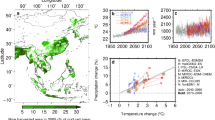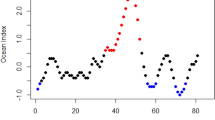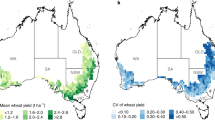Abstract
Large-scale climate oscillations are recognized as skilful predictors of variations in global and regional crop yield. However, the mechanisms linking climate oscillations to crop yield variations remain unclear and are widely assumed to result from crop physiological responses to oscillation-induced local climate variations. Here we assessed the pattern of oscillation-induced yield variations in China over the past four decades and found that El Niño/Southern Oscillation (ENSO) is the primary climatic oscillation associated with extreme yield anomalies, particularly in southern China. These ENSO-related extreme yield anomalies are driven not only by local climate anomalies but also by greater occurrences of crop pests and diseases. Interestingly, the greater occurrence of crop pests is not triggered by local climate anomalies but is linked to ENSO-forced climate anomalies in mainland Southeast Asia, the source region of these pests, fuelled by the ENSO-driven circulation pattern facilitating their migration to China. Given the projected increase in the frequency of ENSO events in a warming future, effectively mitigating such oscillation-induced crop failures requires cross-border collaboration between the source and receiving countries of crop pests.
This is a preview of subscription content, access via your institution
Access options
Access Nature and 54 other Nature Portfolio journals
Get Nature+, our best-value online-access subscription
$32.99 / 30 days
cancel any time
Subscribe to this journal
Receive 12 digital issues and online access to articles
$119.00 per year
only $9.92 per issue
Buy this article
- Purchase on SpringerLink
- Instant access to full article PDF
Prices may be subject to local taxes which are calculated during checkout




Similar content being viewed by others
Data availability
For all oscillation index data, please refer to the literature cited in the Article. Monthly scale meteorological data are available via the CRU dataset at https://crudata.uea.ac.uk/cru/data/hrg/cru_ts_4.02/). The monthly scale SST and wind field data are available via the NCEP/NCAR reanalysis at https://psl.noaa.gov/data/gridded/data.ncep.reanalysis.html. Relevant datasets of pests and diseases in China are detailed in the following links. The occurrence ratio anomalies of two migratory pests at the provincial scale in southern China are available via figshare at https://doi.org/10.6084/m9.figshare.28147505.v1 (ref. 59). Occurrence ratio anomalies of two main migratory pests at the national scale for China are available via figshare at https://doi.org/10.6084/m9.figshare.28147508.v1 (ref. 60). The pest trapping data at the China–Vietnam joint monitoring sites from 2013 to 2015 are available via fFigshare at https://doi.org/10.6084/m9.figshare.28151327.v1 (ref. 61). The occurrence area data of rice migratory pests in Vietnam are available via figshare at https://doi.org/10.6084/m9.figshare.28151348.v1 (ref. 62). Agricultural statistics for China are available via the National Bureau of Statistics of China at http://www.stats.gov.cn/english/. Rice phenology data for the China region are available via figshare at https://doi.org/10.6084/m9.figshare.8313530.v7 (ref. 63), and rice phenology data for the MSA region are available via RiceAtlas at https://doi.org/10.7910/DVN/JE6R2R. Gridded data on pesticide application rates from the dataset PEST-CHEMGRIDS_v1.01 are available via figshare at https://doi.org/10.6084/m9.figshare.7764014.v6 (ref. 64). Source data are provided with this paper.
Code availability
All data were processed using MATLAB v2021b and RStudio (R version 4.1). Most of the statistical analysis was carried out in MATLAB and R. We used the lavaan package in R to build an SEM and the earth package to build a MARS model. We used Python 3.8 for causal analysis with package tigramite, which is available via GitHub at https://github.com/jakobrunge/tigramite. The figures were produced in Origin Pro 2021 and ArcGIS 10.8. Other codes are available upon request.
References
Lesk, C., Rowhani, P. & Ramankutty, N. Influence of extreme weather disasters on global crop production. Nature 529, 84–87 (2016).
Hasegawa, T. et al. Extreme climate events increase risk of global food insecurity and adaptation needs. Nat. Food 2, 587–595 (2021).
Gaupp, F., Hall, J., Hochrainer-Stigler, S. & Dadson, S. Changing risks of simultaneous global breadbasket failure. Nat. Clim. Change 10, 54–57 (2019).
Battisti, D. S. & Naylor, R. L. Historical warnings of future food insecurity with unprecedented seasonal heat. Science 323, 240–244 (2009).
Davis, K. F., Downs, S. & Gephart, J. A. Towards food supply chain resilience to environmental shocks. Nat. Food 2, 54–65 (2021).
McPhaden, M. J., Zebiak, S. E. & Glantz, M. H. ENSO as an integrating concept in earth science. Science 314, 1740–1745 (2006).
Heino, M. et al. Two-thirds of global cropland area impacted by climate oscillations. Nat. Commun. 9, 1257 (2018).
Anderson, W. B., Seager, R., Baethgen, W., Cane, M. & You, L. Synchronous crop failures and climate-forced production variability. Sci. Adv. 5, eaaw1976 (2019).
Iizumi, T. et al. Prediction of seasonal climate-induced variations in global food production. Nat. Clim. Change 3, 904–908 (2013).
Yi, F., Zhou, M. & Zhang, Y. Y. Value of incorporating ENSO forecast in crop insurance programs. Am. J. Agric. Econ. 102, 439–457 (2020).
Friel, S., Schram, A. & Townsend, B. The nexus between international trade, food systems, malnutrition and climate change. Nat. Food 1, 51–58 (2020).
Wang, B. et al. Quantifying the impacts of pre-occurred ENSO signals on wheat yield variation using machine learning in Australia. Agr. Forest Meteorol. 291, 108043 (2020).
Gonsamo, A. & Chen, J. M. Winter teleconnections can predict the ensuing summer European crop productivity. Proc. Natl Acad. Sci. USA 112, E2265–E2266 (2015).
Saji, N. H., Goswami, B. N., Vinayachandran, P. N. & Yamagata, T. A dipole mode in the tropical Indian Ocean. Nature 401, 360–363 (1999).
Cai, W. J. et al. Changing El Niño–Southern Oscillation in a warming climate. Nat. Rev. Earth Environ. 2, 628–644 (2021).
Hurrell, J. W. Decadal trends in the North-Atlantic Oscillation—regional temperatures and precipitation. Science 269, 676–679 (1995).
Porter, J. R. & Semenov, M. A. Crop responses to climatic variation. Philos. Trans. R. Soc. B 360, 2021–2035 (2005).
Ray, D. K., Gerber, J. S., MacDonald, G. K. & West, P. C. Climate variation explains a third of global crop yield variability. Nat. Commun. 6, 5989 (2015).
Zuckerberg, B. et al. Climate dipoles as continental drivers of plant and animal populations. Trends Ecol. Evol. 35, 440–453 (2020).
Lehmann, P. et al. Complex responses of global insect pests to climate warming. Front. Ecol. Environ. 18, 141–150 (2020).
Gutierrez, A. P. & Ponti, L. The new world screwworm: prospective distribution and role of weather in eradication. Agric. For. Entomol. 16, 158–173 (2014).
Cereal production (metric tons) – China. World Bank https://data.worldbank.org/indicator/AG.PRD.CREL.MT?locations=CN (2021).
Wang, C. et al. Occurrence of crop pests and diseases has largely increased in China since 1970. Nat. Food 3, 57–65 (2022).
Lobell, D. B. et al. Greater sensitivity to drought accompanies maize yield increase in the U.S. Midwest. Science 344, 516–519 (2014).
Mehrabi, Z. & Ramankutty, N. Synchronized failure of global crop production. Nat. Ecol. Evol. 3, 780–786 (2019).
Iizumi, T. et al. Impacts of El Niño Southern Oscillation on the global yields of major crops. Nat. Commun. 5, 3712 (2014).
Desai, J. S. et al. Warm nights disrupt transcriptome rhythms in field-grown rice panicles. Proc. Natl Acad. Sci. USA 118, e2025899118 (2021).
Gutierrez, A., Ponti, L. & Arias, P. Deconstructing the eradication of new world screwworm in North America: retrospective analysis and climate warming effects. Med. Vet. Entomol. 33, 282–295 (2019).
Gutierrez, A. P. & Ponti, L. Eradication of invasive species: why the biology matters. Environ. Entomol. 42, 395–411 (2013).
Hu, Q.-L. et al. The genomic history and global migration of a windborne pest. Sci. Adv. 10, eadk3852 (2024).
Runge, J., Nowack, P., Kretschmer, M., Flaxman, S. & Sejdinovic, D. Detecting and quantifying causal associations in large nonlinear time series datasets. Sci. Adv. 5, eaau4996 (2019).
Savary, S. et al. The global burden of pathogens and pests on major food crops. Nat. Ecol. Evol. 3, 430–439 (2019).
Otuka, A., Matsumura, M., Watanabe, T. & Dinh, T. V. A migration analysis for rice planthoppers, Sogatella furcifera (Horváth) and Nilaparvata lugens (Stål) (Homoptera: Delphacidae), emigrating from northern Vietnam from April to May. Appl. Entomol. Zool. 43, 527–534 (2008).
Wang, B., Wu, R. G. & Fu, X. H. Pacific-East Asian teleconnection: how does ENSO affect East Asian climate? J. Clim. 13, 1517–1536 (2000).
Li, J., Wen, Z., Li, X. & Guo, Y. Interdecadal changes in the relationship between wintertime surface air temperature over the Indo-China Peninsula and ENSO. J. Clim. 35, 975–995 (2022).
Chown, S. L., Sorensen, J. G. & Terblanche, J. S. Water loss in insects: an environmental change perspective. J. Insect Physiol. 57, 1070–1084 (2011).
Wang, F.-Y. et al. Determining the migration duration of rice leaf folder (Cnaphalocrocis medinalis (Guenée)) moths using a trajectory analytical approach. Sci. Rep. 7, 39853 (2017).
Padmavathi, C. et al. Temperature thresholds and thermal requirements for the development of the rice leaf folder, Cnaphalocrocis medinalis. J. Insect Sci. 13, 96 (2013).
Yang, S. J. et al. Analysis of atmospheric circulation situation and source areas for brown planthopper immigration to Korea: a case study. Ecosphere 11, e03079 (2020).
Hu, G. et al. Long-term seasonal forecasting of a major migrant insect pest: the brown planthopper in the Lower Yangtze River Valley. J. Pest Sci. 92, 417–428 (2019).
Li, T. et al. Theories on formation of an anomalous anticyclone in western North Pacific during El Niño: a review. J. Meteorol. Res. 31, 987–1006 (2018).
Morishita, M. A possible relationship between outbreaks of planthoppers, Nilaparvata-Lugens Stal and Sogatella-Furcifera Horvath (Hemiptera, Delphacidae) in Japan and the El Niño phenomenon. Appl. Entomol. Zool. 27, 297–299 (1992).
Ko, K. et al. Toxicity of insecticides targeting rice planthoppers to adult and immature stages of Trichogramma chilonis (Hymenoptera: Trichogrammatidae). J. Econ. Entomol. 108, 69–76 (2015).
Gallagher, K. D., Ooi, P. A. & Kenmore, P. E. in Integrated Pest Management: Dissemination and Impact Vol. 2 (eds Peshin, R. & Dhawan, A. K.) 347–358 (Springer, 2009).
Fones, H. N. et al. Threats to global food security from emerging fungal and oomycete crop pathogens. Nat. Food 1, 332–342 (2020).
Maggi, F., Tang, F. H. & Tubiello, F. N. Agricultural pesticide land budget and river discharge to oceans. Nature 620, 1013–1017 (2023).
Cai, W. et al. Increasing frequency of extreme El Niño events due to greenhouse warming. Nat. Clim. Change 4, 111–116 (2014).
Carvajal-Yepes, M. et al. A global surveillance system for crop diseases. Science 364, 1237–1239 (2019).
Nagoshi, R. N. et al. Southeastern Asia fall armyworms are closely related to populations in Africa and India, consistent with common origin and recent migration. Sci. Rep. 10, 1421 (2020).
Zhang, L., Lecoq, M., Latchininsky, A. & Hunter, D. Locust and grasshopper management. Annu. Rev. Entomol. 64, 15–34 (2019).
Liu, Y. Y., Wang, L., Zhou, W. & Chen, W. Three Eurasian teleconnection patterns: spatial structures, temporal variability, and associated winter climate anomalies. Clim. Dyn. 42, 2817–2839 (2014).
Qiu, Y., Cai, W. J., Guo, X. G. & Ng, B. The asymmetric influence of the positive and negative IOD events on China’s rainfall. Sci. Rep. 4, 4943 (2014).
Wang, B., Li, J. & He, Q. Variable and robust East Asian monsoon rainfall response to El Niño over the past 60 years (1957–2016). Adv. Atmos. Sci. 34, 1235–1248 (2017).
Harris, I., Osborn, T. J., Jones, P. & Lister, D. Version 4 of the CRU TS monthly high-resolution gridded multivariate climate dataset. Sci. Data 7, 109 (2020).
Xue, Y. et al. An assessment of oceanic variability in the NCEP climate forecast system reanalysis. Clim. Dyn. 37, 2511–2539 (2011).
Ubilava, D. The role of El Niño Southern Oscillation in commodity price movement and predictability. Am. J. Agric. Econ. 100, 239–263 (2017).
Lian, X. et al. Seasonal biological carryover dominates northern vegetation growth. Nat. Commun. 12, 983 (2021).
Moftakhari, H. R., Salvadori, G., AghaKouchak, A., Sanders, B. F. & Matthew, R. A. Compounding effects of sea level rise and fluvial flooding. Proc. Natl Acad. Sci. USA 114, 9785–9790 (2017).
Wang, C. Two migratory rice pest occurrence ratio anomalies of south China from 1996 to 2016 (provincial scale). figshare https://doi.org/10.6084/m9.figshare.28147505.v1 (2025).
Wang, C. Two migratory rice pest occurrence ratio anomalies of China from 1980 to 2016 (national scale). figshare https://doi.org/10.6084/m9.figshare.28147508.v1 (2025).
Wang, C. 2013–2015 China–Vietnam joint monitoring data on rice migratory pests. figshare https://doi.org/10.6084/m9.figshare.28151327.v1 (2025).
Wang, C. 2010–2016 area of occurrence of two rice migratory pests in Vietnam. figshare https://doi.org/10.6084/m9.figshare.28151348.v1 (2025).
Luo, Y et al. ChinaCropPhen1km: a high-resolution crop phenological dataset for three staple crops in China during 2000–2019 based on LAI products. figshare https://doi.org/10.6084/m9.figshare.8313530.v7 (2021).
Maggi, F. et al. PEST-CHEMGRIDS_v1.01. figshare https://doi.org/10.6084/m9.figshare.7764014.v6 (2021).
Acknowledgements
We are grateful to S. Ainiwaer for her support and contribution to the causal analysis in our research, and we also thank S. Yang, for her detailed comments and suggestions. We thank Q. Fu and H. Jiang from the China National Rice Research Institute (CNRRI) for their suggestions on figure presentations and support in editing this paper. This study has received funding from the National Natural Science Foundation of China (grant nos. 42361144876 and 42171096), Horizon Europe research and innovation programme under the Marie Skłodowska-Curie grant agreement no. 101154967 and the Leibniz Female Professorship Award (application no. P102/2020).
Author information
Authors and Affiliations
Contributions
C.W. and X.W. designed the study; C.W. collected data and performed the analyses; C.W. and X.W. wrote the first draft of the manuscript, with inputs and suggestions from Y.S., C.M., Y.H., L.L, D.C., Q.Z., L.Z., Y.L., F.Z., H.L., F.T., T.L. and S.P.
Corresponding author
Ethics declarations
Competing interests
The authors declare no competing interests.
Peer review
Peer review information
Nature Food thanks Luigi Ponti and the other, anonymous, reviewer(s) for their contribution to the peer review of this work.
Additional information
Publisher’s note Springer Nature remains neutral with regard to jurisdictional claims in published maps and institutional affiliations.
Extended data
Extended Data Fig. 1 The average proportion of different crop loss caused by CPD and rice production loss caused by specific rice CPD since 1980S.
Top, Results of national level. Bottom, results of paddy-field crops dominated regions (southern China).
Extended Data Fig. 2 Relationship between ENSO and rice migration pest occurrence condition in Vietnam.
a, The correlation between winter Niño 3.4 and occurrence area of two rice migration pests in Vietnam from 2010 to 2016. b, The distribution of aggregated occurrence area of two rice migration pests (rice planthopper and rice leaf folder) under two different winter ENSO conditions. The symbol * shows they are different at 90% significant level after Mann-Whitney U two-sided test and the p-value is 0.067. c, Estimated correlation between average occurrence area of rice planthopper and rice leaf folder in Vietnam and winter Niño 3.4 index value from 2010 to 2016 based on bootstrap method.
Extended Data Fig. 3 Spring wind field anomalies at 850 hPa and mean sea level pressure anomalies during the yield-loss years when the winter ENSO index (Nino 3.4) is positive.
The area with grey slash represents the difference tested by the composite analysis at 95% significant level.
Supplementary information
Supplementary Information
Supplementary Figs. 1–23 and Tables 1–10.
Source data
Source Data Fig. 1
This is a zip compressed file, in which the tiff file is the data of Fig. 1a. It is recommended to use ArcGIS or Qgis to open it; the data of Fig. 1b and c are in the Fig1b_and_c.xlsx file.
Source Data Fig. 2
The file contains two sheets corresponding to the coefficients of the latent variables in the SEM model and the path coefficients of the regression. All coefficients are standardized.
Source Data Fig. 3
This file includes five sheets corresponding to the subplots of Fig. 3. It is important to note that the data in Fig. b,c in the sheets are a matrix, not a structured table.
Source Data Fig. 4
The zip file of Figure 4 includes seven files. Figure 4a includes an .xlsx and a .tiff file. The tiff file is raster data of MSA precipitation anomalies, and the xlsx file is data of longitude, latitude and rice planting area grade data. Figure 4b includes a .tiff file of rice planting area and a .xlsx file for box plots. Figure 4c is two .tiff files of two SST data (winter and spring SST) and a .tiff file of rice harvesting area. We recommend to use ArcGIS or Qgis to open .tiff files.
Source Data Extended Data Fig. 1
There are two sheets corresponding to the pie charts a and b in Extended Data Fig. 1.
Source Data Extended Data Fig. 2
There are three sheets corresponding to a (scatter plot), b (box-and-line plot), and c (histogram) in Extended Data Fig. 2.
Source Data Extended Data Fig. 3
This table contains five columns for latitude, longitude, sea level pressure field anomalies and U- and V-shaped wind anomaly at 850 hPa. When plotting, the U and V need to be vector-summed to get the final direction of the wind field.
Rights and permissions
Springer Nature or its licensor (e.g. a society or other partner) holds exclusive rights to this article under a publishing agreement with the author(s) or other rightsholder(s); author self-archiving of the accepted manuscript version of this article is solely governed by the terms of such publishing agreement and applicable law.
About this article
Cite this article
Wang, C., Wang, X., Sang, Y. et al. Oscillation-induced yield loss in China partially driven by migratory pests from mainland Southeast Asia. Nat Food 6, 681–691 (2025). https://doi.org/10.1038/s43016-025-01158-3
Received:
Accepted:
Published:
Issue date:
DOI: https://doi.org/10.1038/s43016-025-01158-3
This article is cited by
-
El Niño drives international pest migration
Nature Food (2025)



